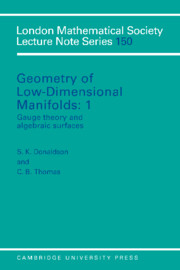Book contents
- Frontmatter
- Contents
- Contributors
- Names of Participants
- Introduction
- Acknowledgments
- PART 1 FOUR-MANIFOLDS AND ALGEBRAIC SURFACES
- 1 Yang-Mills invariants of four-manifolds
- 2 On the topology of algebraic surfaces
- 3 The topology of algebraic surfaces with q = Pg = 0
- 4 On the homeomorphism classification of smooth knotted surfaces in the 4-sphere
- 5 Flat algebraic manifolds
- PART 2 FLOER'S INSTANTON HOMOLOGY GROUPS
- PART 3 DIFFERENTIAL GEOMETRY AND MATHEMATICAL PHYSICS
1 - Yang-Mills invariants of four-manifolds
Published online by Cambridge University Press: 16 February 2010
- Frontmatter
- Contents
- Contributors
- Names of Participants
- Introduction
- Acknowledgments
- PART 1 FOUR-MANIFOLDS AND ALGEBRAIC SURFACES
- 1 Yang-Mills invariants of four-manifolds
- 2 On the topology of algebraic surfaces
- 3 The topology of algebraic surfaces with q = Pg = 0
- 4 On the homeomorphism classification of smooth knotted surfaces in the 4-sphere
- 5 Flat algebraic manifolds
- PART 2 FLOER'S INSTANTON HOMOLOGY GROUPS
- PART 3 DIFFERENTIAL GEOMETRY AND MATHEMATICAL PHYSICS
Summary
This article is based on three lectures given at the Symposium in Durham. In the first section we review the well-known analogies between Yang-Mills instantons over 4-manifolds and pseudo-holomorphic curves in almost-Kahler manifolds. The second section contains a rapid summary of the definition of invariants for smooth 4-manifolds using Yang-Mills moduli spaces, and of their main properties. In the third section we outline an extension of this theory, defining new invariants which we hope will have applications to connected sums of complex algebraic surfaces. Finally, in the fourth section, we take the opportunity to make some observations on pseudo-holomorphic curves and discuss the possibility of using linear analysis to construct symplectic submanifolds, in analogy with the Kodaira embedding theorem from complex geometry.
SECTION 1, ELLIPTIC TECHNIQUES IN TOPOLOGICAL PROBLEMS
The last ten years have seen the development and application of new techniques in the two fields of 4-manifold topology and symplectic geometry. There are striking parallels between these developments, both in detail and in general methodology. In the first case one is interested primarily in smooth, oriented 4-manifolds, and the problems of classification up to diffeomorphism. In the second case one is interested in, for example, problems of existence and uniqueness of symplectic structures (closed, nowhere degenerate, 2-forms). In each case the structure considered is locally standard : the only questions are global ones and it is reasonable to describe both subjects as “topological” in an extended sense of the word.
- Type
- Chapter
- Information
- Geometry of Low-Dimensional Manifolds , pp. 5 - 40Publisher: Cambridge University PressPrint publication year: 1991
- 6
- Cited by



